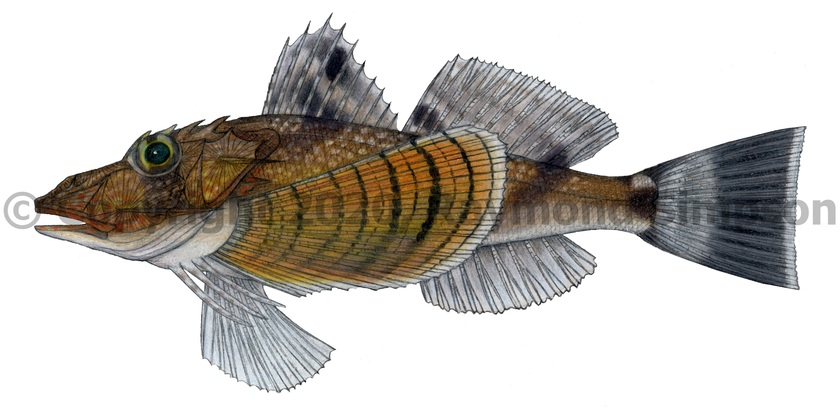
Common Name
Bighead Searobin
Year Described
Cuvier, 1829
Identification
Dorsal Fin: X, 12
Anal Fin: 10
Pectoral Fin: 13-14
Gill Rakers: 8-16 (first arch)
Body robust (noticeably heavier looking than congeners) but elongate and slightly compressed . Head is large, bony, and heavily sculptured with pronounced ridges and spines. Head profile sloped and not very steep. Duck-billed snout is long. Mouth is subterminal and large in size, containing bands of villiform teeth on the jaws, vomer, and palatines. Jaw reaches front edge of orbit. No spines at nostrils. Preopercle and opercle usually bear strong spines. Preopercular spine reaches beyond opercle. Large, fan-like pectoral fins with strongly branched rays, with the lower three rays free, thickened, and separate from the fin membrane. Pectoral fin viewed from above asymmetrically rounded (more blunt anteriorly). Pectorals when folded reach middle of anal fin base. Two dorsal fins: one spiny and one soft rays. Anal fin opposite soft dorsal fin. Caudal fin is truncate. Pelvic fin underneath pectoral fin on belly. Body covered in small ctenoid scales. Throat to area in between pelvic fins scaled. Nape scaled. Opercular membrane above spine partially scaled. Lateral line is continuous.
Color
Body pale brown with numerous close set lines, scrawls, and spots forming a reticulate pattern of light and dark. Usually has three oblique dark brown bands under the dorsal fins. Head with same pattern as body and usually a dark eyeband. Spiny dorsal fin mottled brown and white with an ocellated black spot between spines 4-5. Soft dorsal mottled brown with white spots along the rays and a thin white edge. Body bands often extend onto fins. Pectoral fins reddish brown to golden brown with bold black crossbands across most of fin (anterior membranes often plain). Smaller fish with thicker bands. Edge of whole fin white. Free rays plain white or banded in brown. Anal and pelvic fins plain whitish to blue with white edges. Tail red-brown to brown with a narrow gray band and a brown basal area and white rear margin.
Size
Maximum size to 45cm SL.
Habitat
Soft bottoms from 9-183 m (usually 9-64m).
Range
New York to the Gulf of Mexico to the Yucatan Peninsula. Continental coasts only.
References
McEachran, J. D. & J. D. Fechhelm. 2005. Fishes of the Gulf of Mexico. Volume 2: Scorpaeniformes to Tetraodontiformes. University of Texas Press, Austin. i-viii +1-1004.
Richards, W. J. & G. C. Miller. 2003. Triglidae (pp. 1266-1277). In: Carpenter, K. E. (ed.) 2003. The living marine resources of the Western Central Atlantic. Volume 2: Bony fishes part 1 (Acipenseridae to Grammatidae). FAO species identification guide for fishery purposes and American Society of Ichthyologist and Herpetologists Special Publication No. 5. FAO, Rome. v. 2: i-vii + 602-1373.
Other Notes
This species and Prionotus evolans have a noticeably different body and head shape (wider body, bigger and smoother looking head, more gradually sloping snout) than other members of the genus in the area. This species is easily distinguished by having no lateral stripes.